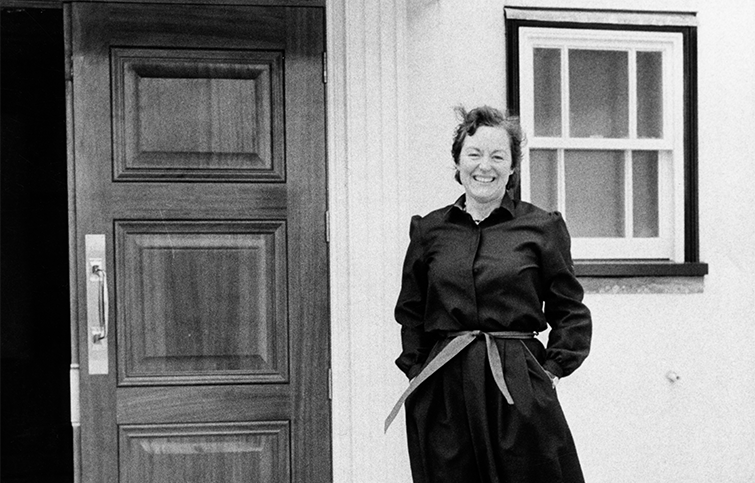Make a difference
People like you help us every day through regular donations
Read stories DonateIt is 40 years since the first case of HIV/AIDS in the UK and the death of Terry Higgins in 1982. On 1st December 1988, the Terrance Higgins Trust released 1,000 balloons to commemorate the approximate number of recorded UK AIDS cases the previous year – this was on the first World AIDS Day.
 Watching the series ‘It’s a Sin’ on TV, I realised that I had lived through this time involved in the historic story of the AIDS epidemic.
Watching the series ‘It’s a Sin’ on TV, I realised that I had lived through this time involved in the historic story of the AIDS epidemic.
St Helena Hospice opened in May 1985. At that time the main criteria for care was for people with life threatening disease for whom cure was no longer the prime objective but appropriate care for the patient and their family was needed. The admission criteria then was mainly cancer and motor neurone disease, although conditions such as Parkinson’s disease and multiple sclerosis were admitted for respite care and to support them through end of life care. Gradually it was seen that those with end stage disease and other diagnoses needed similar skills.
I explain this as I describe how caring for people with HIV and AIDS suddenly became a challenge for the hospice movement. We were suddenly hearing about a new disease with an almost 100% death rate. It seemed to affect young people and particularly gay men and needle sharing drug users. At that time there was a lot of prejudice about gay people who were often reluctant to admit their relationships.
Little was understood about this new disease at first. Gradually we learnt that it was caused by the Human Immunodeficiency Virus (HIV). People could have no symptoms for some time. The onset was insidious, tiredness, weight loss, general debility. The effect on the immune system led to fatal opportunistic pneumonias and some cancers were more common, particularly one called Kaposi’s sarcoma which caused purple lesions visible on the skin.
In addition to general ignorance about this disease and how it spread, there was a lot of prejudice about sexual orientation. People applying for mortgages and life insurance were asked very personal questions about their sexual behaviour. Some even lost their jobs in an atmosphere of criticism and distrust. These attitudes led to people moving away from their families and isolating themselves.
It is worth remembering the sensation caused by Princess Diana shaking hands with patients with AIDS without gloves and cuddling infected children.
How should the Hospice respond? It was obvious the acute infections needed active treatment in hospital but at other times these people and their families needed skilled medical and nursing care and much emotional support. Surely hospices had a role to play.
However, there was much resistance mainly due to fear of loss of charitable revenue due to the prejudice of many of the public against people who contracted it.
I felt strongly that we had a role to play, as did many staff. After quite a bit of resistance it was agreed we could admit people with AIDS or who were HIV positive. It is hard to explain now, almost 40 years later, what an achievement this was.
We had hurdles to overcome. In this atmosphere of fear and ignorance, the families of staff and volunteers were very worried and vocal about the risks they felt were being taken. To overcome this and support them we ran training courses for staff, volunteers and their families to try to reassure them. I explained frequently that there was no risk if the usual infection prevention regime was used correctly: gloves and hand washing.
In response to the need for care for an increased number of people, many young, the Terrence Higgins Trust (named after one of the first people in the UK to die of an AIDS-related illness), opened the London Lighthouse in 1988 (closed in 1998). As with the hospice movement, they developed expertise in the particular problems found in this condition. Other centres and wards developed too as there were problems specific to this condition and pooling experience was the best way to develop expertise.
We did not look after a large number of people with AIDS throughout the 80s and 90s. Often it was more appropriate for them to be in acute hospitals to receive intensive treatment for the infections or cancers that developed. Sadly, many people isolated themselves away from family and friends too ashamed to seek help or fled to London to become more anonymous. Our main role was respite care and symptom control but particularly emotional support for themselves and their families. The community team became an important link.
Gradually the AIDS epidemic changed over the years with the availability of drug treatments leading to a normal life expectancy, and the acceptance of varied relationships is making diversity the norm.
During 60 years since qualifying as a doctor, there have been many changes and incredible advances in medicine. This records just one of them but one well worth remembering. 
This story and images may not be reproduced without express permission from St Helena Hospice.

When you make a donation to St Helena Hospice, we are charged transactional fees by other companies, including fees for processing payments made to us, looking up addresses and validating bank account details.
We are very grateful to our donors who offer to offset some of these fees with a minor addition to their total amount. This is however completely optional and we are very grateful for your support whether or not you choose to contribute to processing fees.
CloseWe are able to claim an extra 25p on every £1 on your donation amount for no extra cost to you, as long as you are a UK tax payer; have paid enough income tax or capital gains tax in that tax year; and are donating your own money. If you pay less income tax and/or capital gains tax than the amount of Gift Aid claimed on all of your donations in that tax year it is your responsibility to pay any difference. For more information about Gift Aid, please visit https://www.gov.uk/donating-to-charity/gift-aid
